
Tribe; What Lies Beneath, Port of Spain, Trinidad
Take a good look at this billboard and J'Ouvert band. Let your mind drift over these farfetched concepts in carnival designs, 2005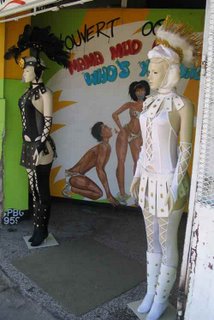
Looking for MF S&M W&B 
Who's yuh daddy
..................................................................................................................
The mas camp which occupied the lower part of a building at the corner of Belmont and the Queen's Park roundabout has been demolished.
Monday, November 28, 2005
Really Nothing
Sunday, November 27, 2005
Eying De Man - LeRoy
This work looks as if it came out of the 1950s  Revelation …Cogitative Dimensions is a retrospective of LeRoy's Clarke’s work from 1998. The upper floor of the National Museum of Trinidad and Tobago is allocated to the exhibition alone.
Revelation …Cogitative Dimensions is a retrospective of LeRoy's Clarke’s work from 1998. The upper floor of the National Museum of Trinidad and Tobago is allocated to the exhibition alone.
LeRoy Clarke's paintings are kinetic in nature. The artist uses a technique of stippling to assert an energy depicting African accents which gives each canvas its own independent meaning. From the embryo, his compositions expands into arches, angles and vectors. Step back a distance, and the camouflage of these complex idioms are exposed.
The show includes figurative pieces. These white outlines may represent the female, uprising, empowerment or LeRoy Clake himself as a patriarchal African head.  Mr. Clarke's work can be heavy-handed, his paintings can be lost in the muddiness of his palette or by the complexity in his narrative. Correct lighting can lift the intricacies from the work.
Mr. Clarke's work can be heavy-handed, his paintings can be lost in the muddiness of his palette or by the complexity in his narrative. Correct lighting can lift the intricacies from the work.
Friday, November 25, 2005
Thursday, November 24, 2005
The vending machine

The Art Society of Trinidad and Tobago Gallery host the painter, Karen Sylvester, 2005
From the moment she entered the arena of Art making and selling, Karen Sylvester has generated much talk and speculation. The emotion is mostly of the green kind. People huddle with you in corners of the gallery and talk about how much money she is making and what they have heard about her private life. This is not so unusual in Trinidad and Tobago. The Art community is small and going to shows is like going to a family outing, there are always characters to encounter, people to duck, people to air kiss and people to approach like long lost family. Behaviour is to be monitored, food and drink to talk over and lots of empty conversation to fill awkward spaces.
Yet, with Karen Sylvester and her work, I have found an artist who is consistently and unexpectedly controversial because she is perceived as a success. It is said that heavy is the crown of the King. But in this case, heavy is the emotion of the court. At her last show held at the newly named Art Society of Trinidad and Tobago by the master of selling art, Mark Perriera, I found myself looking at her work with the vaguest memory of the whispers. No one ever says Ms. Sylvester cannot paint. No one ever says that she is unable to convince you that her plants and rolling hills are not nearly photorealistic in nature. What everyone gets up in arms about is how well she is doing. Is this a representation of how we in Trinidad treat each others success? I went in search of the answers to the questions that keeps coming up about the artist. 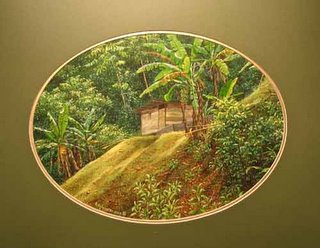
An oval view of tranquil quaintness of Trinidad and Tobago
There is a violent divide about what art should be in Trinidad and Tobago, and some how Miss Sylvester is caught up in the hailstorm. I don’t hear the wrangling questions against photorealism at a Neal Massy show? I don’t hear it at a Larry Mosca show? But at a Karen Sylvester show there is no middle ground. There are either people who love her pastoral poetry or those who hate it. Everyone is a critic.
I was asked to write about Miss Sylvester many years ago when a large painting she had done of the Wildflower Trust of lotus flowers was priced at TT$200,000. No one could stop talking about the cost of the work. Unlike the American artist W.H.McNeill Whistler’s Nocturne more than a century ago, no one was getting up in arms and stating publicly that she should justify her price. People were just agog at what a painting could fetch. The work was not sold at that show. It has subsequently been sold. Yet, it was a big moment in local art history. 
LeRoy Clarke’s current exhibition at the National Museum of Trinidad and Tobago
It harkened back to LeRoy Clarke’s million dollar sale of his work that did cause much brow beating and nashing of teeth. This begs another question, should artists have to justify their prices? Why does the art community and the art buying public get so sensitive when an artist can actually ‘make a living’? Why get up in arms when an artist calls a price? 
The envy in any Trinidadian's living room
As I walked around the gallery space, so much improved from the years of dusty, none descript raw space, now sparkling new with good light and air conditioning, I saw some new developments in her work. Her ‘Mash Dog” and “Cane Cutter” are examples. There are people inhabiting the land, unlike much of her work in the past that featured only nature. But this is not the development. Looking more closely at the latter painting, one can see an attempt to break out of a tried, tested and proven technique, an attempt to bring more expression to composition and use of media.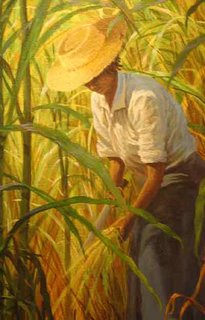
Cutting through the technique of what she is capable of painting
It cannot be easy being so successful with a style of work. I asked Neal Massy at his last show this year, how he handles doing new things. He too has steadily explored new ideas in his work, for example the use of sfumato, a hazy middle ground invented by Leonardo Di Vinci. Mr. Massy is also now adding a bit of typography in signage where his lone birds perch, as well as looking at interior spaces. These works are introduced in small ways into the show, practically placed first or last in an attempt to not jolt the buyer into seeing something too radically different from a steady style of work.
This begs the next question. All artists work to make a living, ie. Make money. So why is it that so many artist have a hard time with the artists who make successful livings selling work of a particular nature? Yes I have seen a million landscapes, Magnificent Seven, old house, black woman with turban until I can draw them in my sleep. As a commodity our society does not tire of these representations of our ‘culture’ and ‘heritage.’ For many buyers the thought expressed is that they want the uncomplicated and pretty, and the more ‘radical’ contemporary artists take up their toys and setups, accusing them of bad taste, no taste and god forbid, nouveau riche ways. But if these same people were to turn around and say let me see your work again…well! The arguments are that her work is soulless. That she uses a projector that she traces from photography. There is too much of that photorealism around. She’s polluting the market with same old, same old. This is a circular argument. 
The Coca-Cola formula of painting
Our is an ambivalent crowd. On the one hand there are the pretty painters, the Sunday painters and on the other hand there are the Abstract Expressionists and the New Media specialists. With very little ground and no tolerance it is plain to see that works that do not tear or interfere with the social fabric of the nation shall always be with us.
Everyone can work, everyone is different. So why is Karen Sylvester always in the headlights? This shall not end here, but I shall do so by stating, Miss. Sylvester’s career unwittingly encourages many questions. Holding up many opinions to serious scrutiny, all pointing outward at us, and in the life of an artist, is that not what good work is supposed to do anyway? - Adele. Also see the article on Photorealism versus Paintrealism
Tuesday, November 22, 2005
Cycle...a short student film
A competition focusing on short independent films has aroused secondary school students in Trinidad and Tobago to participate in a project where video is used as a medium to voice their concerns over peer pressure, bullying and school gangs. Cycle is a production of the Barataria secondary school and their submission is a vivid portrait of what ready goes in classrooms across Trinidad and Tobago
Anglelo is marking his territory, (note the emphasis on the shoe, and the detail of the logo) and proceeds to bully the smallest boy in class. 
Kyle is accused of controlling the form 1 students and a scuffle between the two gangs ensues.
Terry, a gang member and rival to Anglelo's hood, says that this is all about disrespected and offers Kyle a real solution to solve the problem. He addresses him as Horse, meaning a wild one.
Not only does Kyle suffer at school, but he has to contend with domestic violence at home.
A war erupts between both factions, and a gun is used to end the fight.
Cycle ends with an alternative solution to solve these types of disputes
Michelangelo Di Lodovico Buonarroti
Shitting stones
David in pampers, St. James, Port of Spain, Trinidad
In the vaults below Bill Gates' estate, in his vast collection of journals and notebooks from artists from the Renaissance, a square leather crafted handbook once belonging to Michelangelo Di Lodovico Buonarroti highlights his crowning achievement. Written in the margin, the Italian sculptor writes;
“To my achieving act as God’s abiding servant, shall the heart of man bring forth, my humblest statue David shall be transformed to the island of Trinity, there he shall be clothed, only then shall God rest.”
Believe it on not, Michaelangelo’s intolerance to the hypocrisies of clergymen allowed him to immortalize their portraits by cleverly disguising the their faces into his fresco paintings as the penis heads of the male nudes not clearly visible from the ceiling of the Sistine Chapel.
The statue of David, clothed with what appears to be a packed and soiled Preveil Protective adult pamper.
Michelangelo once remarked, "The accuracy of carving feet posed his greatest challenge". Placed outside the Palazzo Vecchio, the sculpture stands at 14' 3'' tall.
.................................................................................................................
What is astonishing about this billboard is that some thought must have taken place to fuse these three elements together.
1. The statue of David
2. A young female model #
3. One large pamper
#. Bed-wetting not only affects the aged, but the young, the beautiful and the feminine. The woman in the sign is simply comfortable with the garment bunched around her waist.
.......................................................................................................................................................................
This sign does not exist anymore
Monday, November 21, 2005
Panic..Panic..Panic
I eh hearing nutting at all, but dat is nutting....Clap for meh
The stills above are of Denise Belfon, and the name of her dance is called Peddle, it is like she says, riding a bicycle motionlessly.
Denise Belfon is a treat to see. Men just salivate over her dance moves, and women admire the fact that she is capable of controlling every living man on this green planet earth with her motor skills and ball bearing waist.
A side view of Cleopatra squatting in tempo and vibrating her pelvic to a audience in awe
Denise has an attraction and following of magga men who generally attempt to wine with her in competition, but fail miserably as "Saucy Wow" can literally toss them aside with the jar of her hip. See the post, when the world is at war
“Saucy Wow", alias, Denise Belfon
.................................................................................................................
Terms and meaning
Wine: A dance to Trinidad and Tobago based on African gestures in courting
Magga: A thin framed person
Saturday, November 19, 2005
Photorealism versus Paintrealism?
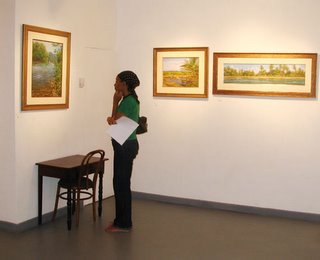
Karen Sylvester's paintings, is it Photorealism versus Paintrealism?
In Trinidad and Tobago the art of choice, the art that people like best, can’t get enough of, whether we like it or not, is photorealism. There are a few practitioners of note here: Peter shim, Neil Massy, Karen Sylvester, to name three of the best. They are financially successful, to the chagrin of many other serious artists who think they are more serious than that. It’s not their fault they are successful, if fault, indeed, it is. If the type of art they have chosen – or has chosen them, depends how you look at it – is what people want - not necessarily discerning collectors, but buyers, cooperate and not, who can afford the prices these fellows ask, and get – then what’s the beef with them. Not even artists can live on empty belly, it takes money to buy food, and I glad their belly full, and their wife’s’ and children’s’, too.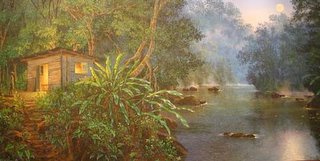
Light and water Sylvester's Palette
In Trinidadian terms, Ms.Sylvester is a master in her own right
Except that: You really can get this type of thing anywhere, just that the scenery changes.
And: what is the purpose of copying a photograph, when the photograph does it very well all on its own? And: so you can do it, just like a photograph, you have the skill, but what’s next, where. to from here? And: what about a change of subject matter, applying equal skills?
And: a little emotion: rage, despair, grief, ecstasy, joy, mirth - all those over-the-top kind of things. And: a little character, a little more …. depth. And: is it always best to give the people what they want, even for all the money (food) in the world? 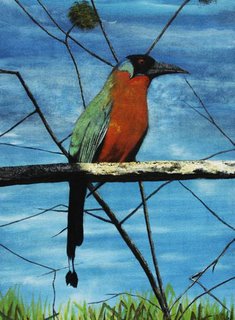
A roadside painting
The Photographer Noel Norton exhibition at Clico, Port of Spain. A journey of 50 years where his work is printed on cheap ink jet paper to appear like canvas and framed without the importance of this exhibition itself.
After all, fulfill the potential implied in the skill and intelligence you very obviously possess - or you wouldn’t ever have achieved what you’ve already achieved. And we’re waiting for the move forward and outwards towards something more meaningful, even if it is as unsettling, as accidental as Larry Mosca’s more and more peculiar renderings of the landscapes supporting the wildlife in his pictures – interesting despite himself.
You have to eat, its true. We all do, even prostitutes, who also protest they love their work, and are providing an important and necessary service, at least to clients, and, of course, they are exploited and degraded for it. Exploitation degrades us all, and to facilitate it is to degrade yourself, your talent, your potential, your art. And there is the very real risk of getting stuck, mired in the gimmick, the technique, the virtuosity-for-virtuosity-sake effect, and the perfection of perfection, without a single sign of struggle, even a mistake here and there, surely the road to heartless, bloodless boredom, for both artist and audience alike.
An important art work by Carlise Chang and Noel Norton. The mural, "Nobility of Man" destroyed despite the public outcry to save it during the airport's renovations

Eric Williams with John Lennon's degraded digital print. An appalling photographic retrospective
As artists, we have each been given an instrument to play. There’s nothing wrong with staying in the middle of the range, but there is all that other stuff out there, at the top and bottom, bass and treble, and it seems to me a shame not to go there every now and then, if only, ultimately, to learn a little more about ourselves. For surely that is the largest and most beneficent aspect of this priceless gift (and burden) that has been given to us. - Stuart

A photograph of Hail Salessie with Eric Williams on a his visit to Trinidad and Tobago

Xerox colour copies displayed in a odd walkway gallery, Port of Spain Trinidad
Thursday, November 17, 2005
Less Merciful, Less Compassionate

Master of the Day of Judgment
Show us the straight path
Thee alone we worship; Thee alone we ask for help
A Bahrain player who used any means to score a goal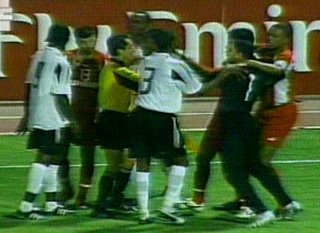
The disputed goal turned ugly
The path of those whom Thou hast favoured; Not the path of those who earn Thine anger nor of those who go astray
.............................................................................................................
The display and utter disrespect to Trinidad and Tobago at the World Cup qualifying match in Bahrain, 2005
Quotes from the al-Qur'an: of which the sacred writings of Islam were spoken from God to the prophet Muhammad
Wednesday, November 16, 2005
Ode An die Freude

A Soca Warrior heading a ball high in mid-air
The moment that caused car horns to blare in Trinidad and Tobago
Weltmeisterschaft fur T&T
Der Countdown zur Fußballweltmeisterschaft in Deutschland
A nation erupting into celebration over its win in Bahrain
A great day for a small country.
.................................................................................................................
The win over Bahrain which qualified Trinidad and Tobago' Soca Warriors to be part of the World Cup, Germany, 2006
Saturday, November 12, 2005
A Nation on the verge of a nervous breakdown

The Soca Warriors are too relaxed, overconfident and cocky
The Bahrain team is focused
Allah; “In the name of God, the Merciful, the Compassionate"
God; “Creator of the Heavens and Earth”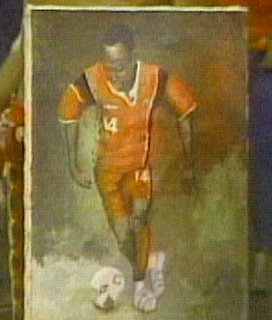
Art in the Stadium, a painting of Dwight Yorke, the captain of the Soca Warriors team
The painter himself with a carnival fancy Indian head piece
Head butt into a T&T net
What a Goalie most fears
Flowered with gifts when he arrives home in Bahrain
But there is a saying that God is on the side of Trinidad and Tobago
Netted equalizer
One down, be we are unsure what his Nation can offer.
..........................................................................................................................................................................
Television stills from the qualifying match between Bahrain and Trinidad and Tobago in Port of Spain, Trinidad, 2005
Disclaimer:
Amendments to such articles if misleading or with grammatical errors shall be corrected accordingly.
All photographs, Feinin studies, accompanying quotes, articles and visual headers appearing on site are the exclusive property of Richard Bolai © 2004 - 2010 All Rights Reserved.
Any fare use is restricted without written permission
